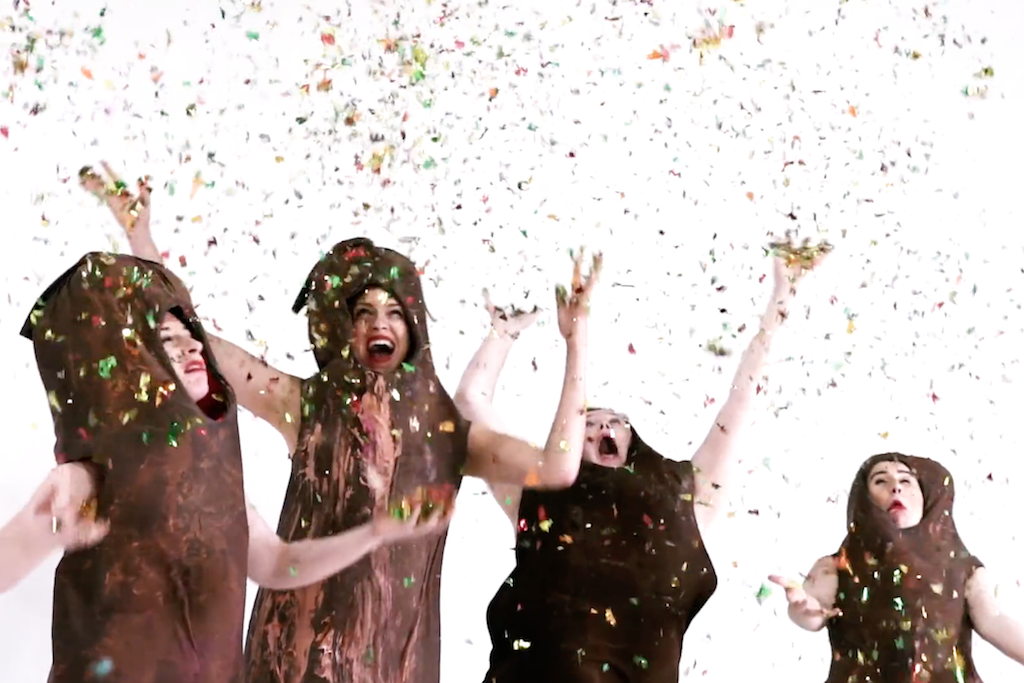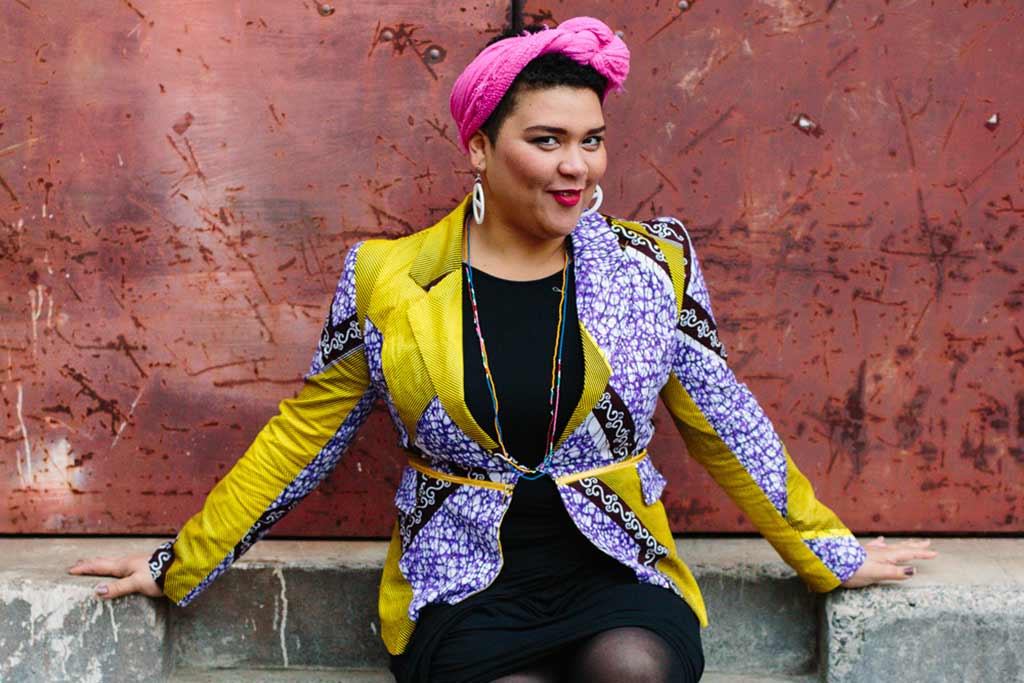What You Can Do To Fight The “Sausage Party” In Australian TV And Film
Let’s get into the meat of this issue.

Earlier this week, a group of renegade woman-sized sausages hijacked Australian film’s night of nights in a bid to “end the sausage party!” The wiener brigade were a group of women filmmakers from Sydney representing WIFT (Women in Film and Television). The comical disruption was administered as a means to highlight the woeful gender inequality and the lack of transparency regarding selection criteria for the 2016 AACTAs.
Though many raised valid concerns the protest was insensitive to non-binary and trans people — conflating sex and gender can be hurtful and it can be difficult to unpack up against the conforms of cis-gendered heterosexual majority — I must say I saw the action as light-hearted, and I was in fits of laughter at the “sausage protest” on the red carpet.
Protesters dressed as sausages chanting to “end the sausage party” of the Aust. film industry forcefully ejected from #aactas red carpet pic.twitter.com/8aeM0p1UdV
— steph harmon (@stephharmon) December 7, 2016
There is a rather sad internet rabbit hole one can slide down to read about statistics regarding gender imbalance in film and TV and the number of female grads versus industry take-up etc, so I won’t re-cover that ground. Instead, I want to carve into the real meat of it (so to speak). Why do white men make up 70-85 percent of writers, directors and producers on Aussie films? In the case of this year’s AACTAs, white male directors took up 93 percent of the pan.
Is this because white men are simply better storytellers and better at the technical elements of making cinema? Is it because white men of the world dominated the birth of the Western form and therefore defined ‘masterpieces’ for their demographic? A phrase thrown around feminist screen advocacy groups for a decade now is “if you can see it, you can be it”. Are the pathways for white men on a whole simply easier because they look the part?
Also, what can be done about all this now?
The State Of Things In 2016
At the recent MEAA Equity Summit which took place earlier this month at the Malthouse Theatre in Melbourne, Gillian Armstrong (My Brilliant Career/ Little Women), Sue Maslin (producer of The Dressmaker), Nadia Tass (Malcom) and Anna Kokkinos (Head On) spoke on a panel entitled Female Filmmakers on the Frontline.
They discussed the incredible sexism (plus added classism and racism in Kokkinos’ case) they came up against shooting their first films. Armstrong was feared to “faint in the dessert because [she] was a girl” and Maslin was told there wouldn’t be an audience for such a strong female-focused work. Boy did they prove those fellas wrong!
Keeping a film in cinemas remains key – THE DRESSMAKER was in theatres for 21weeks. $27m – 1.5% total box office. Extraordinary. #ausfilm
— Lauren ?? (@LCarrollHarris) November 16, 2016
But the result shouldn’t be surprising. This is invariably what happens when a team of brilliant filmmakers get to work on projects they’re passionate about. Unfortunately, they face many obstacles in even making it to that point. Kokkinos explained in detail the barriers to becoming a ‘master’ filmmaker and said that essentially making a film is only a quarter of the battle. Filmmakers then have to fight for screenings at festivals and general distribution — let alone selections for awards.
Some might think, but isn’t it this hard for anyone — male or female, white or black, able-bodied or not? The plain answer is no. Statistically it is almost 10 times harder for a female filmmaker to have their film seen, let alone folks who are from intersectional backgrounds. Armstrong, Maslin, Tass and Kokkinos agreed that the woeful gender imbalance in films made by women on our screens is a reflection of the male-heavy stranglehold on networks, awards and distribution.
And then, if you get the bloody thing on, you have to contend with the white, male dominated critics circle. Holy hotdog!
Flipping The Narrative
I asked the magnificent Sophie Mathisen (head sausage, filmmaker and WIFT leader) what she sees as her greatest obstacle in the field and essentially why she dressed as a sausage for her first appearance on the AACTAs red carpet.
“It’s time to fight for our rights as women filmmakers and raise awareness about the inequality we face even if that means putting our bodies on the line,” she said. “My art practice is inherently linked to the fate of all women.”
To suggest that men are somehow genealogically superior at telling stories is ridiculous.
Sophie outlined what she sees as AACTA’s poor form on the issue and has countered with a charter asking for “transparency, consistency and intensity of commitment”. When asked about merit, and the argument that films made by white men might just be better than work made by… well anyone else, Sophie responded strongly. “Merit is a cipher for privilege, institutionalised and unconscious bias. To suggest that men are somehow genealogically superior at telling stories is ridiculous.”
The answer reminded me of a quote I had read from Transparent showrunner Jill Soloway. Arguing that women are naturally suited to be directors, she said “We all know how to do it; we fucking grew up doing it!” “It’s dolls. How did men make us think we weren’t good at this? It’s dolls and feelings. And women are fighting to become directors? What the fuck happened?”
There’s every reason for this to change. Women make up the largest growing audience of Netflix, and still comprise the majority of film audiences. We’re also craving new perspectives. I always know I’m watching a Jane Campion piece because of the sex scenes — I feel the female gaze deep between my thighs at those moments and this is why I’m hanging out for Top of the Lake 2. Kokkinos switches between softness and grit in a way that captures the queer in all of us. Soloway makes incredible stories with a huge array of identities and births a level of empathy unseen on the small screen.
But these are still exceptions to the rule. Are we happy with the way we’re being depicted, and are we happy supporting an industry that locks women filmmakers out?
What Can Be Done
If you’re not happy with this, then join WIFT (you don’t have to be a filmmaker), join WITS (Women in Theatre and Screen), become a patron, fund Pozible campaigns for female filmmakers, rent sausage costumes (WIFT are putting theirs up for grabs) and throw conscious-raising parties, interrogate all the films you watch. You can write to local cinemas and ask why you’re not seeing more films by women, push your male filmmaking buddies to work with women, and push your rich mates to nurture a budding female filmmakers.
Acknowledgment of unconscious bias and entrenched systems blocking anyone who isn’t a cis-gendered white man has begun. Government screen bodies across the country are beginning the process of shifting the male centre of Australian filmmaking through various initiatives.
The take-up from women at every level of their film careers has been incredible. Almost 500 applied for Screen Australia’s Gender Matters program in the first instance, and it was just announced that 935 women have applied for Imogen Banks and Alice Parks’ Smart for a Girl TV-writing course; there are only 12 positions.
Screen NSW is on track for the “50/50 by 2020” gender target and has successfully set up the first series of internships for people with diverse abilities. The candidates are ready and showing up in full force. Of course this is just the start. There will need to be a long-term investment from the industry funding bodies to shift the paradigm and create an inclusive environment.
In a crazy climate where the likes of popular misogynist, Donald Trump can be the president of the United States of America and Russian lad Vladimir Putin can imprison Pussy Riot, know that the need for grand gestures and even grander support is now at a critical level. This sausage fest is the wurst.
–
Candy Bowers a passionate performer of fearless sticky performance, theatre, music and spoken word. She has appeared on Q&A, been published in Yours Truly, and hosted The Circle.
